CarEdge saved me over 4,500 dollars on a brand new Honda Pilot. I can't say thank you enough.
Price intelligence
Find a wide range of vehicle listings with market insights on new and used listings near you.
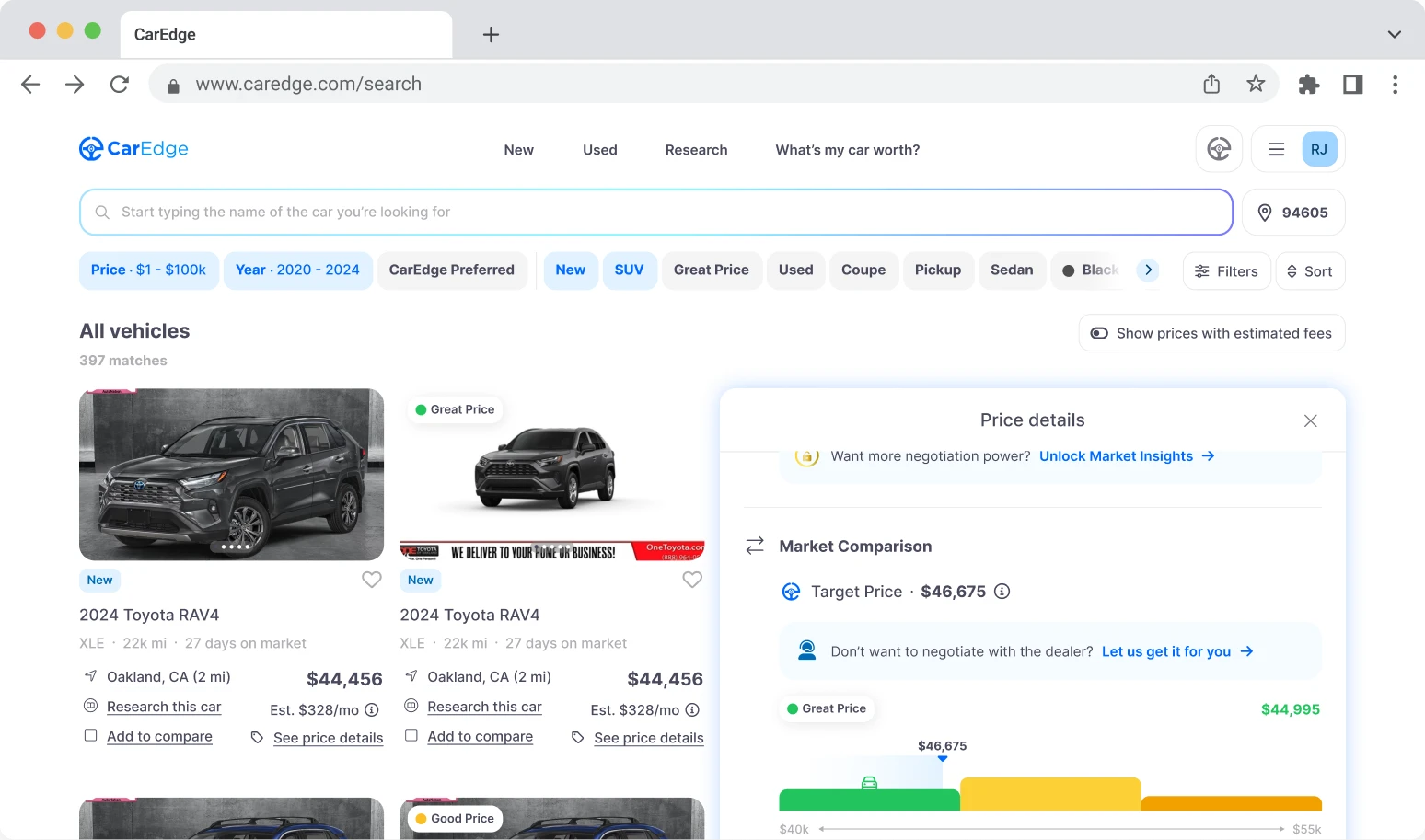

Help us personalize your CarEdge experience — it only takes a second.
Your answers help us personalize your CarEdge journey — we’ll follow up with tips and next steps that match your buying timeline.

The last six months of 2022 brought softening car prices after 18 months of gains. Used car prices are down 17% at the wholesale level, and retail prices are finally coming down. Will new car prices drop in 2023? Will we continue to see used car prices drop in 2023? Here’s what the data tells us.
Expect used car prices to continue a steady decline through at least the first half of 2023. For new cars, it’s a bit more complicated, as we explain below.
From March of 2021 through early 2022, used car prices climbed by over 50%. Just as used car prices began to soften in mid-2022, inflation soared through the roof, acting as a parachute for falling prices.
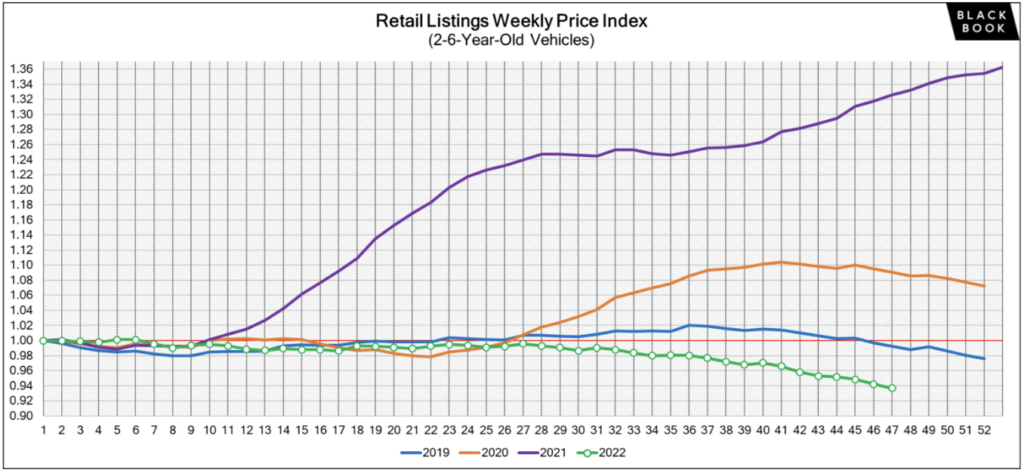
Still, no matter how you look at the data, used car prices have fallen over the past six months. Data from industry analysts at Black Book shows that retail used car prices have decreased consistently as demand decreased, mostly due to interest rate APRs shooting up dramatically. It now costs thousands of dollars more in interest to finance a car, especially for big borrowers with 72+ month loans.
See our weekly used car price update here.
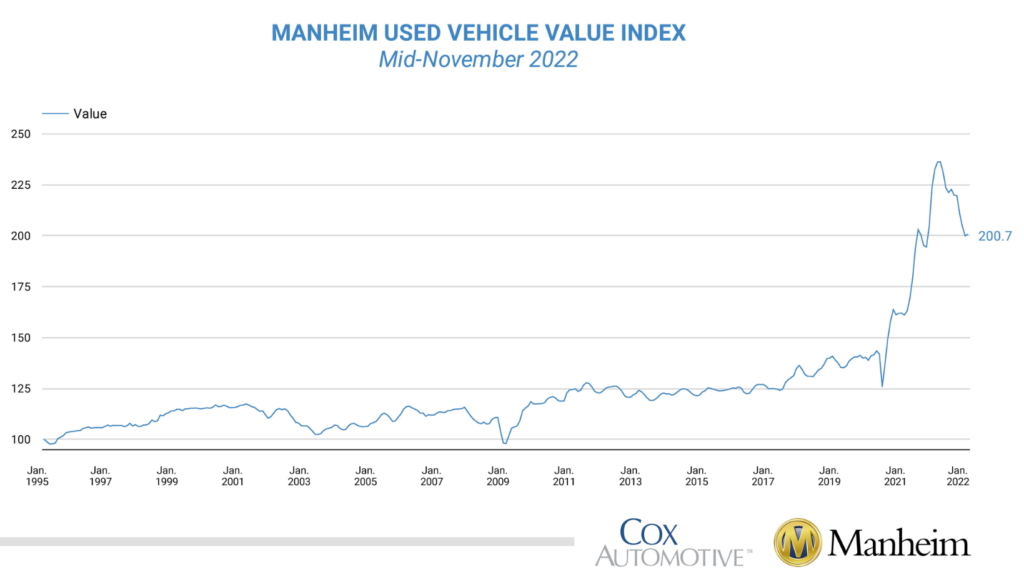
In 2023, all signs point towards used car prices continuing to fall. If you’re wondering where all of these lower prices are, there’s a good reason for that. The most common metric used to track car prices is transaction price, or how much a buyer actually pays for the car. This is different from the sticker price. Dealers have been slow to drop sticker prices, but they’re much more willing to negotiate with buyers who put in the effort.
Why are cars more negotiable? Used cars aren’t selling as quickly, and rising interest rates mean that floorplanning costs are putting pressure on dealerships to sell soon, rather than hold on to inventory. Every day a car sits costs them money.
Don’t expect used car prices to freefall in 2023, barring a severe economic downturn. Prices will in all likelihood continue to trend downward, becoming slightly more negotiable with each passing month.
Demand for affordable vehicles remains high, but unfortunately dealers are stuck trying to cover their losses. What losses, you ask? Thousands of car dealerships quite frankly paid too much for cars at wholesale auctions over the past year. Now that prices are falling, dealers are trying to squeeze every last dollar out of each deal. Therefore, we expect softening used car prices in 2023, but only moderate month-to-month price declines.
On CarEdge Car Search, we’ve been seeing used cars sitting on dealership lots for longer, and as floorplanning costs rise with interest rates, dealers are dropping prices.
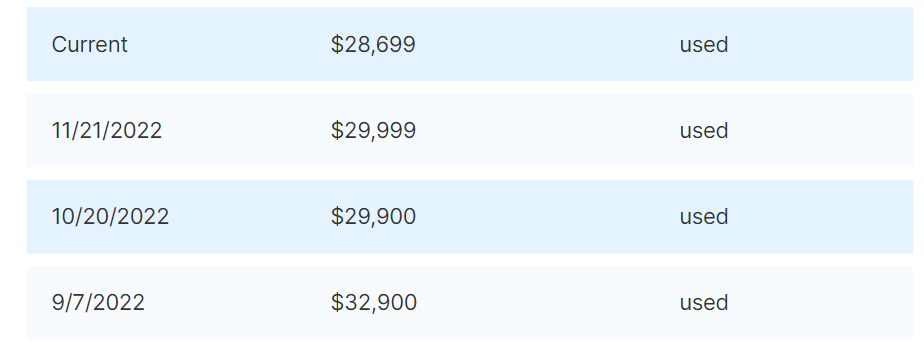
There’s less optimism on the new car front, but 2023 will still bring better prices to those who are patient and willing to negotiate.
In 2021, the chip shortage slammed automakers, and new car inventory was down to roughly one quarter of pre-pandemic norms. Now, new car inventory levels are increasing, slowly but steadily. Over the past year, new car inventory levels in the United States have risen from a low of about 900,000 cars per month to 1.6 million cars per month, and we expect to see inventory numbers increase closer to 2 million cars per month in the near future.
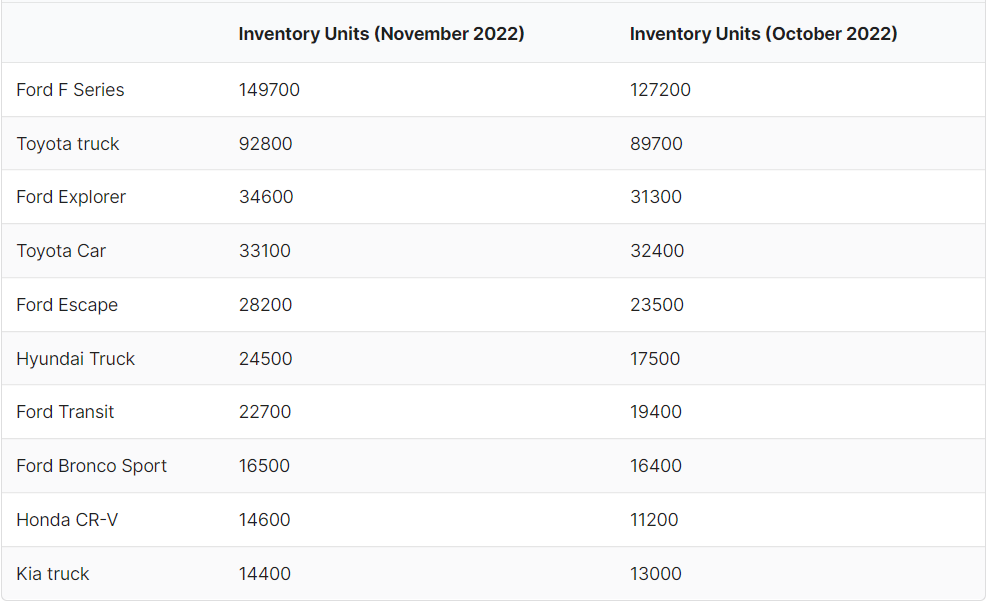
These numbers are still below historical norms, but automakers have increasingly made it clear that inventory will never be as high as it was back in 2019.
There’s a lot of pent-up demand for new cars, especially when it comes to hybrids and EVs. For most if not all of 2023, expect popular models to fly off the lot as quickly as automakers can produce them.
For other more mainstream models, it will once again be possible to negotiate new car prices below MSRP. In fact, our members are reporting more success with new car deals already. Check out some of their amazing success stories.
According to Kelley Blue Book, manufacturer incentives remain near all-time lows around 2% of the average transaction price. In late 2021, incentives averaged 4.3% of ATP. Go back to early 2020, and incentives averaged 11% of transaction prices. Wow!
Why are new car incentives going to remain low? Automakers have been forthright about their intentions to keep inventory low, even after supply chain challenges are put behind us. Without a glut of new cars waiting to be sold on dealer lots, there’s no reason to bring back big incentives. This post-pandemic strategy is a win for dealers and automakers, at the expense of vehicle affordability for buyers.
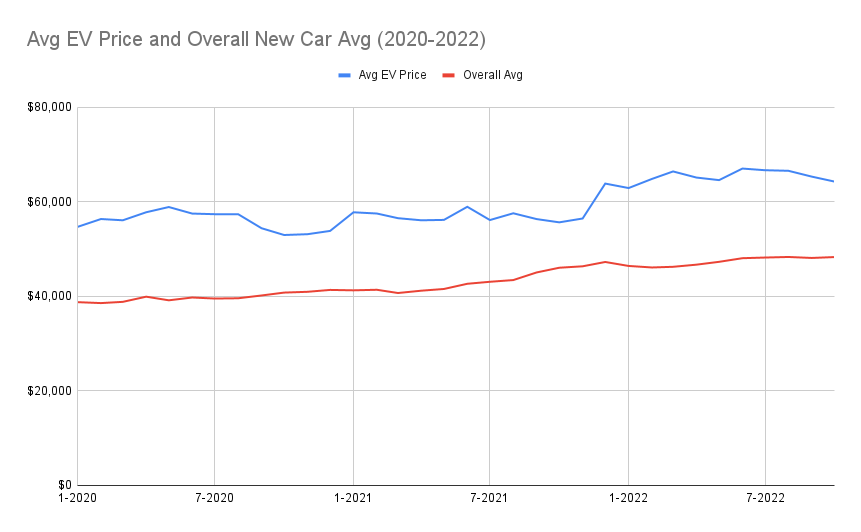
In November of 2022, the average transaction price for an electric vehicle in the U.S. was $64,249. That’s $16,000 more than the average price paid in the overall auto market. As you can see in the graph above, EV prices have remained parallel to the overall market for years. That could soon be changing, but not for reasons you’re likely to expect.
Automaker executives have recently said that price parity for their electric and combustion lineups is just a few years away. Are EVs going to get cheaper that quickly? A few new, lower-priced EVs are on the way, but that’s not the main factor that will likely turn their price predictions into reality.
What is? Take a look at where MSRPs are headed for all new cars, including those powered by internal combustion engines. CarEdge Auto Expert Justise Lasley says that signs point towards electric vehicle prices remaining high, but traditionally-powered models will continue to receive MSRP hikes, ultimately resulting in ‘price parity’.
Simply put, EV prices may have peaked (and on average may start to fall), but other cars will get more expensive, possibly even catching up to EVs.
However, there are a few affordable EVs we’re excited about. All of these will be available in late 2023.
If you’re thinking about going electric in 2023, you might find these resources helpful:
Yes, you can expect car prices to drop in 2023, but in most cases, you’ll have to work for it. Dealers are holding out with higher prices, hoping that buyers who don’t keep up with the market will stumble into their showrooms.
Would a car buying coach make this whole process easier for you? CarEdge is changing car buying for the better. This is LONG overdue, isn’t it? Check out hundreds of free resources, or learn more about how CarEdge can help you negotiate a better deal today.

As we head into December 2022, new car inventory is the highest it has been in nearly two years. Finally, it seems that automakers are climbing out of the supply chain problems that brought the industry, and car buyers, to a halt for much of 2021 and 2022. Which car brands will have the best deals in December? Who will have the most inventory on the lot? We spoke to CarEdge Auto Experts Justise Lasley, Mario Rodriquez and Phil Nader to find out.
Be sure to check out these other CarEdge member favorites too (updated monthly):
The Best All-Around New Car Deals Today
The Best Lease Deals This Month
The Best Auto Loan Rates Right Now
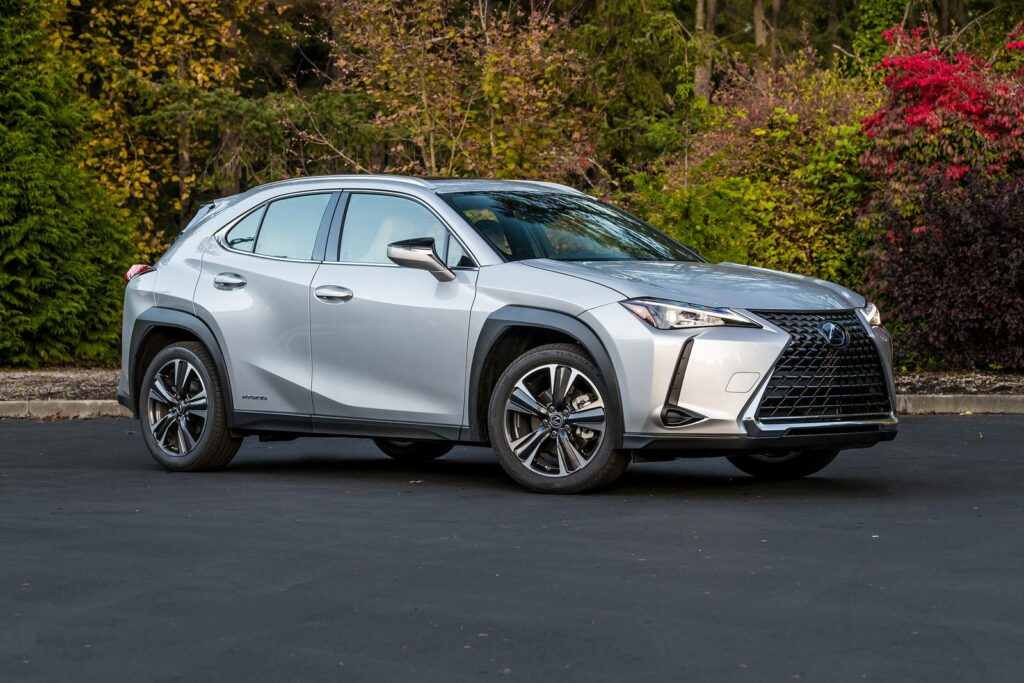
The Lexus RX continues to be a great deal option with high allocations to dealers before the refreshed 2023 model arrives. It’s not just new 2022 Lexus models, either. CarEdge’s Mario Rodriguez said that low-mileage used Lexus models are priced very well right now.
“December is the best month for Lexus, which should bring some good incentives. Target end-of-year car sales for the most leverage at negotiating a Lexus deal.”
One of our CarEdge+ members just got a great deal on a Lexus UX 250h using CarEdge tools and the empowerment that comes with understanding your deal. Check that out here. We’d love to help you save thousands of dollars on your car purchase!
See new and used Lexus inventory in your area.
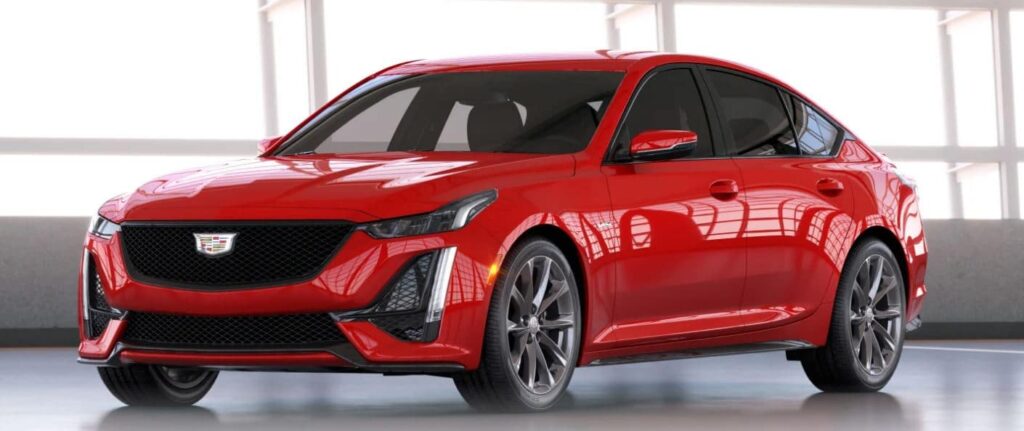
CarEdge’s Phil Nader highlighted Cadillac’s higher inventory numbers and overall luxury price trends. Luxury car brands have seen the largest price declines over the past six months. This is most obvious with used luxury car prices, but new luxury models are more negotiable than at any point earlier this year.
“Cadillac is seeing higher inventory levels and an average incentive of $2,600,” Phil said. “Expect to see pricing under MSRP on the CT4, CT5 and XT4, XT5 and XT6. Buyers should feel confident that prices can and should be negotiated to 5% below MSRP.”
However, General Motors CEO Mary Barra has indicated that GM will never return inventory to pre-pandemic levels, making GM leaner and more efficient. In other words, they won’t have as many reasons to discount prices if they intentionally keep inventory below historic norms.
See new and used Cadillac inventory in your area.
Negotiate like a PRO with this car buying cheat sheet
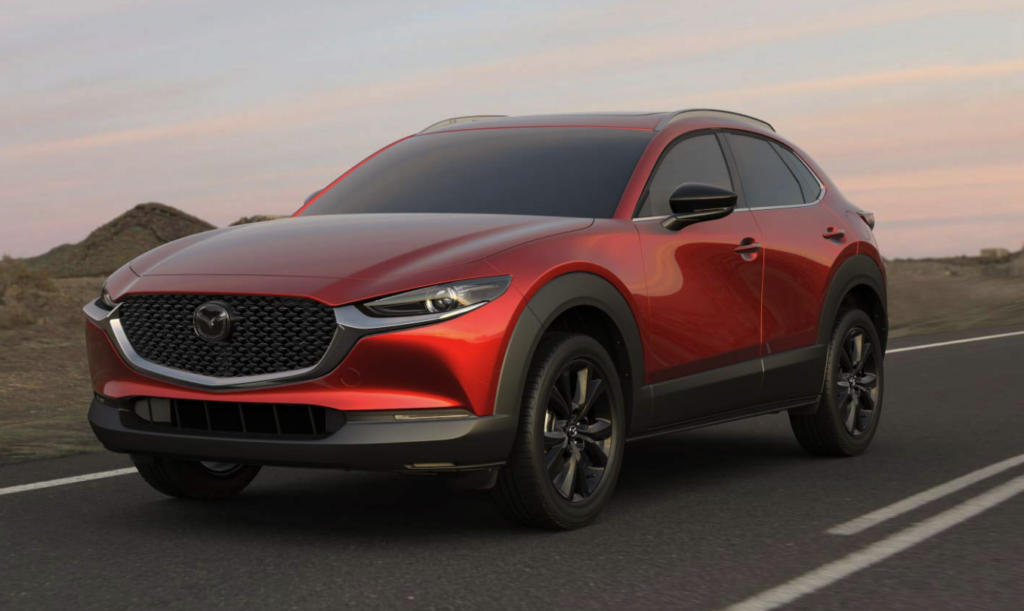
The Mazda CX-9 and other models are available with good manufacturer incentives and dealer discounts. Mazda just dropped their lease financing to 0% APR, so leases are looking very attractive. For example, right now the following Mazda lease deals are advertised for these 2023 models:
Outgoing 2022 model-years have great financing offers right now. The 2022 CX-9 has 1.9% APR for 36 months with no payments for 90 days. Most other 2022 Mazda models have 2.49% APR right now too.
We expect even better Mazda deals in the second half of December.
One of our members successfully negotiated a great deal on a 2023 Mazda CX-5. The dealer was still pushing back, but as you can see here, Mazda dealers are motivated to sell, despite their determination to force junk fees.
See new and used Mazda inventory near you.
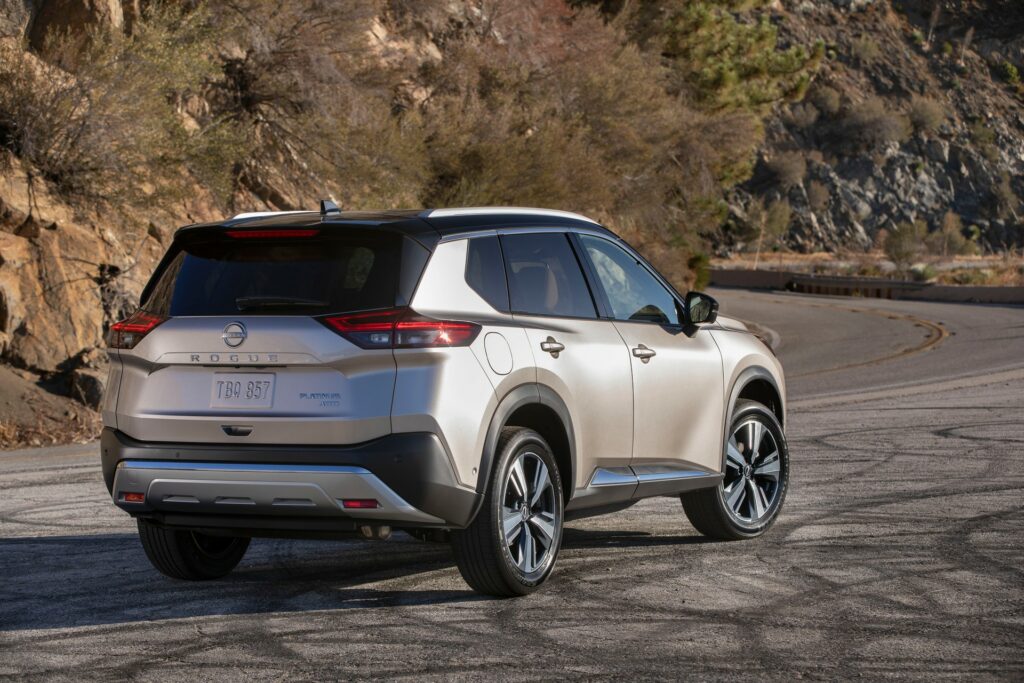
Right now, our CarEdge Auto Experts are helping Nissan buyers with negotiable deals on the Nissan Altima, Rogue and Murano, especially in the mid-spec SV trim. Mario says that the best Nissan deals are in the Northeastern U.S., but good Nissan deals are becoming more common in the rest of America too.
These are the best Nissan offers this month:
Our CarEdge+ member was even able to seal the deal on a Nissan Pathfinder Platinum at MSRP using CarEdge’s proven negotiation tactics. See our member’s amazing accomplishment here.
Note: The best Nissan deals may be short lived. Of the automakers on this list, Nissan faces the most severe ongoing inventory shortages. Nissan’s U.S. sales tumbled 31 percent in the first nine months of 2022. In November, further production cuts were announced. The Altima, Frontier and Titan will become harder to find in a month or two.
See new and used Nissan inventory near you.
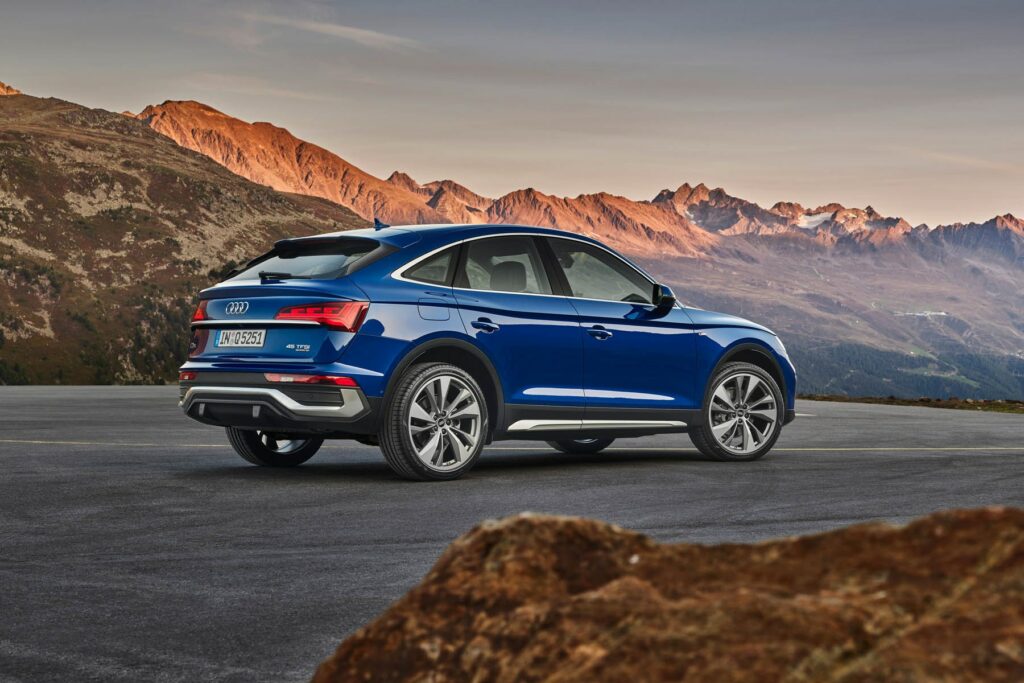
Luxury cars are negotiable today, and the prices will continue to drop in December. CarEdge members have successfully negotiated 7-10% off of MSRP on the Audi Q5 and Q7.
Sedans such as the A5 can be had at or near MSRP, as proven by CarEdge member Elan recently. We expect more negotiability in December as year-end car sales get underway.
Audi is offering finance deals right now, with most models available at 3.99% APR for 72 months. Most other automakers are limiting their competitive APR offers to no more than 48 months, so this is a rare opportunity.
See new and used Audi inventory near you.
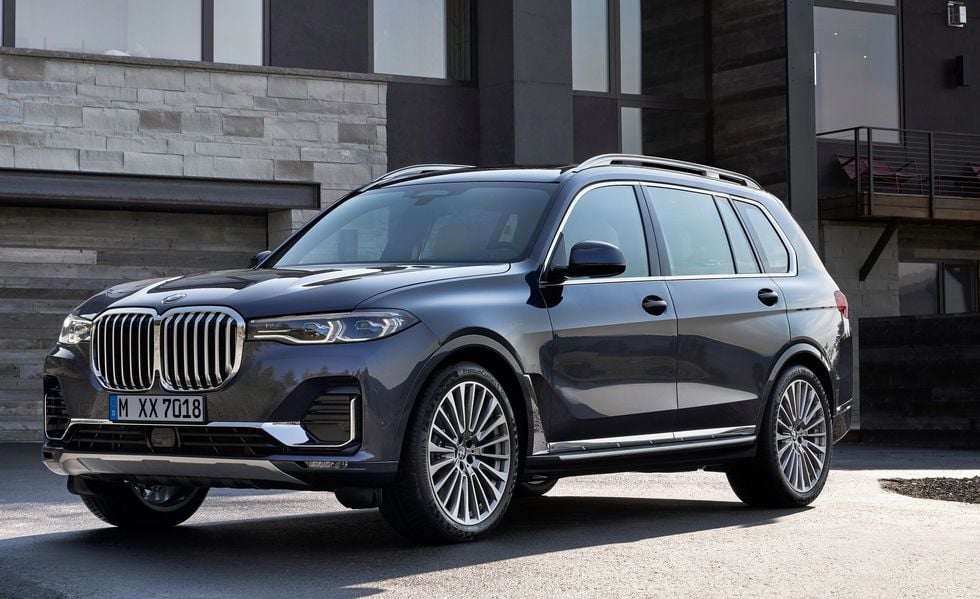
Our Auto Experts are helping members negotiate 6-9% off MSRP for the BMW 3 and 5 series. The BMW X3 and X5 can be negotiated 6-9% off MSRP in some regions.
One of our members had a MASSIVE win with a BMW M340i xDrive recently. They negotiated $2,000 off of MSRP on one of the most difficult cars to find in the country right now. We’re confident this is a sign of even more negotiability to come with BMW and other luxury brands.
See new and used BMW inventory near you.
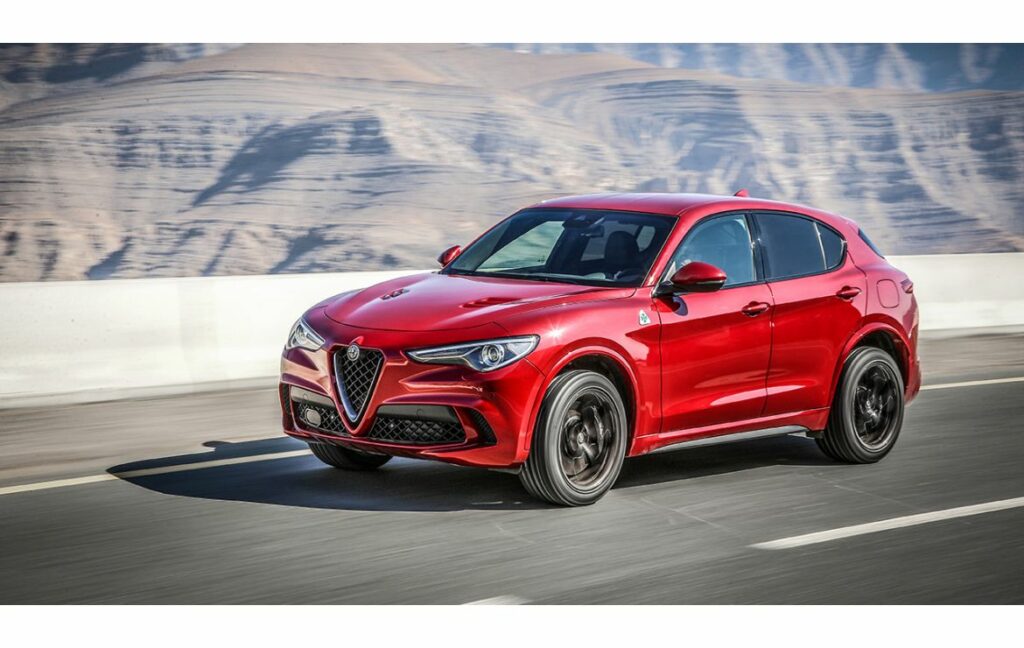
CarEdge Auto Expert Mario says that Alfa Romeo models are quickly becoming negotiable in late 2022. The Stelvio should be possible at 7-10% below MSRP. In fact, bringing the price below MSRP should be your expectation for at least the Stelvio in December.
At the very least, don’t pay over MSRP for the cars mentioned above. If your preferred dealer isn’t ready to negotiate pricing on these models, you should expand your search radius. I know it sounds ridiculous, but I myself saved $4,000 by purchasing my Hyundai IONIQ 5 a few hundred miles away from home. You likely won’t have to go that far.
We could see better deals from Ford, GM and Stellantis (notably Ram and Dodge) in December. Their inventory is higher now, and that’s a great sign for buyers.
Follow the CarEdge FREE resources blog for the latest car price updates! We hope to see you on the free CarEdge Community forum, where thousands of car buyers and owners come together to empower the consumer.

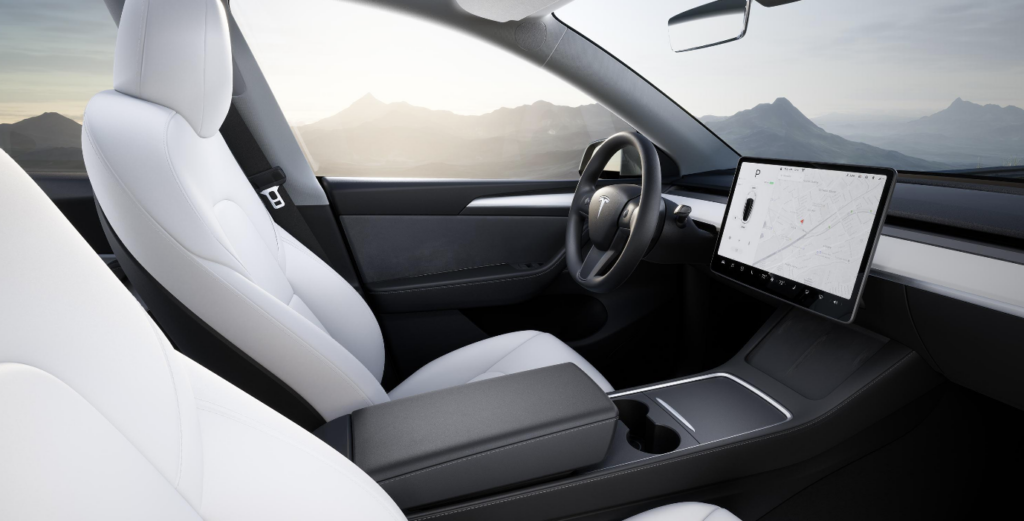
One third of American drivers are seriously considering going electric as generous tax credits, fuel savings and reduced emissions lure the masses towards EVs. My own household made the switch in early 2022, and we’re never going back to ICE. In hopes of adding clarity to the current EV market, we’ve created this resource to share what we think are the BEST electric cars, trucks and SUVs in 2023. We’ve also shared what we think are the worst.
These models are stand-outs for their value. Range, charging speed and available features are given priority over performance in our analysis.
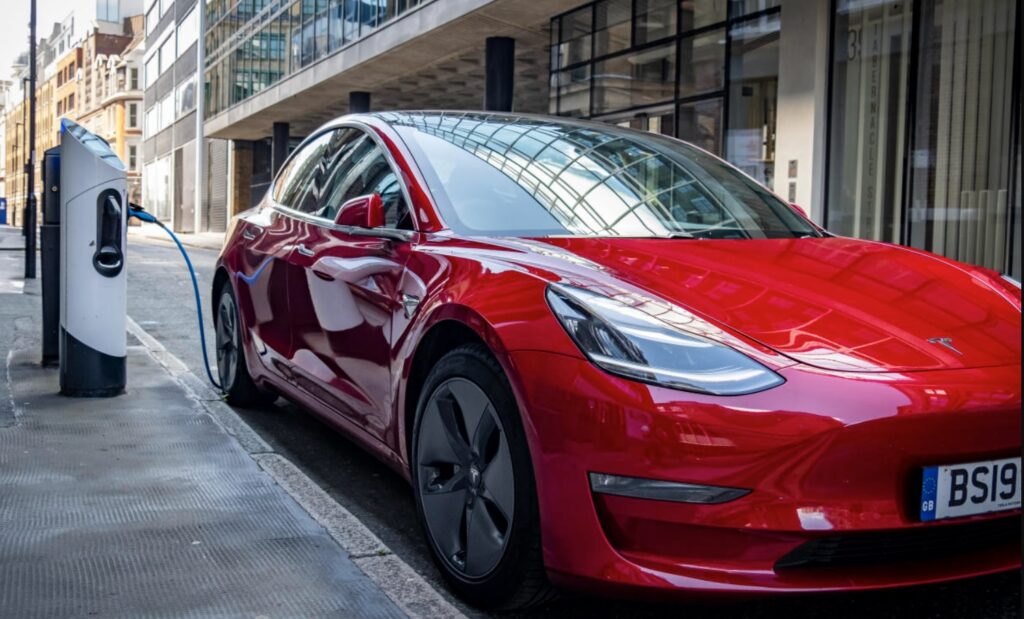
Price: $41,990
Range: 272 miles
Fast charging (adding 200 miles in 20-30 minutes)
Why it’s great: The Tesla Supercharger network makes cross country travel hassle-free. Tesla charges are very reliable, and with 1,500 locations in all 50 states, finding one is rarely an issue.
Plus, the price you see on Tesla’s online configurator is the price you pay (before taxes and required fees, of course). While legacy automakers continue to struggle with out-of-control dealer markups, Tesla and other direct-to-consumer EV makers have the upperhand on pricing.
See pre-owned Tesla inventory near you, or configure a new Tesla at Tesla.com
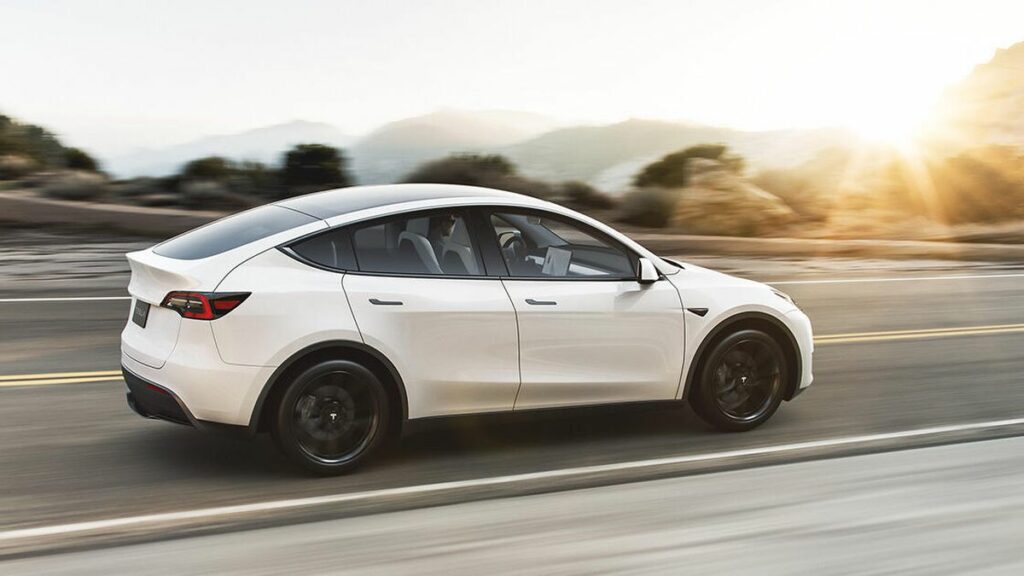
Price: $52,990+
Range: 330 miles
Fast charging (adding 200 miles in 20-30 minutes)
Why it’s great: The Model Y is the larger, more family-oriented version of the Model 3. Last year, the Model Y overtook the 3 as the best-selling EV in America. Although it is the most expensive model on this list, if you can afford it, the ease of public charging, great range, spacious interior and exhilarating performance all make this the sweet spot for many buyers. Plus, there are no dealer markups.
But wait, there’s more. Both the Model Y and Model 3 are available for delivery soon after placing an order. Tesla wait times are between one and three months as of late 2022. That’s about as good as it gets in today’s EV market.
Should you ever decide to sell, both of these Teslas have amazing resale value.
See pre-owned Tesla inventory near you, or configure a new Tesla at Tesla.com
Check out this resource: The Best Electric Vehicles Under $50,000
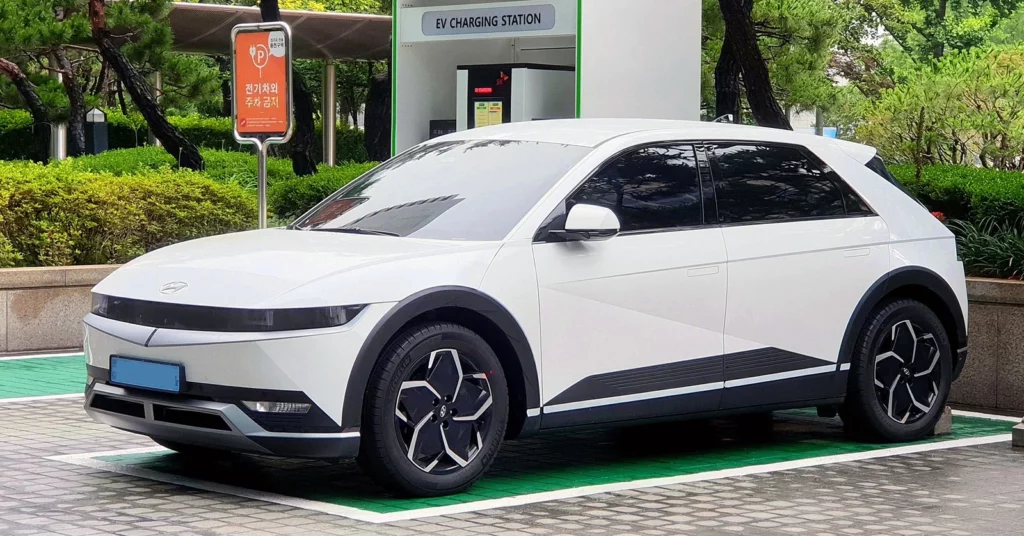
Price: $46,250 (dealer markups are common but negotiable)
Range: 303 miles
Fast charging: Add 200 miles of range in 20 minutes
Why it’s great: The 2023 IONIQ 5, Kia EV6, and Genesis GV60 are the first models powered by Hyundai Motor Group’s Electric Global Modular Platform. This is next-gen 800-Volt architecture at (relatively) affordable prices, and that’s awesome.
Plus, the IONIQ 5 is spacious, and looks really cool. Sadly, Hyundai has had a very difficult time scaling up production due to supply chain constraints, so expect to either wait for at least six months, or battle outrageous dealer markups to get your hands on a rare allocation.
I love my IONIQ 5. Here’s a review of my ownership experience so far.
See Hyundai IONIQ 5 inventory near you.
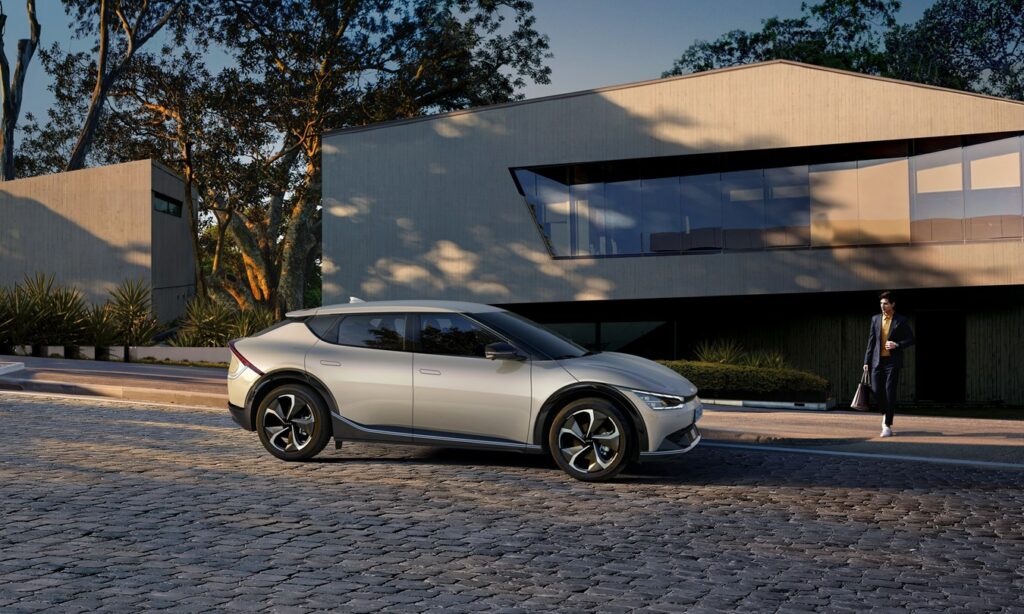
Price: $49,795 (dealer markups are common but negotiable)
Range: 310 miles
Fast charging: Add 200 miles of range in 20 minutes
Why it’s great: Kia’s version of the IONIQ 5 looks completely different, with very similar specs. That’s because both models share the e-GMP platform with great range and even better charging.
The 2023 EV6 has slightly more availability than the IONIQ 5 right now. For the 2023 model year, Kia decided to drop the “Light” base model, kicking the entry-level price all the way up to nearly $50,000.
As always, I recommend everyone take a test drive before dismissing EVs. They’re quiet, efficient and fun. The EV6 would be a great one to take for a spin.
See Kia EV6 inventory near you.
Here’s every electric truck’s pricing and range.
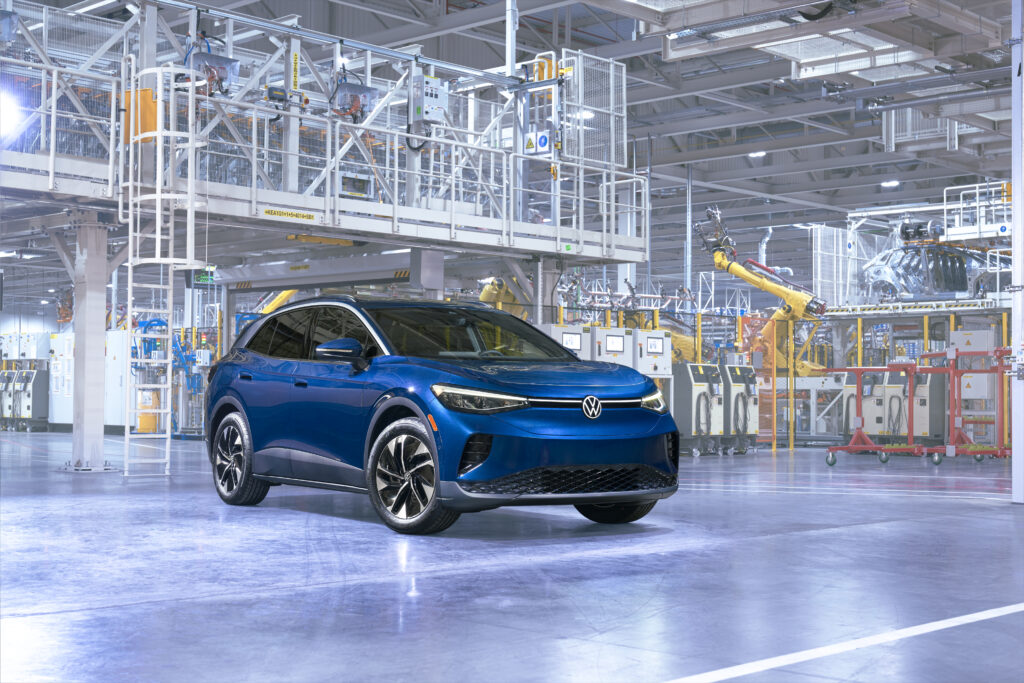
Price: $42,495
Range: 275 miles
Fast charging: Add 190 miles of range in 28 minutes
Why it’s great: The VW ID.4 is now made in America at Volswagen’s Chattanooga, Tennessee factory. That means it will qualify for the revised EV tax credit (up to $7,500), as long as your VIN confirms that it is an American-made ID.4. I was impressed during my test drive of the ID.4. It rides like a luxury crossover, and has plenty of acceleration when you need it. However, it’s definitely the least sporty of this bunch, but it’s also the least expensive.
Now made in America, there is also a new cheaper option starting at $37,495. However, with public charging infrastructure slow to build out, the expected 208 miles of range is not enough for us to confidently recommend it to anyone but those who expect to stick around urban areas 95% of the time. The ID.4 Pro, on the other hand, is exceptional value with the EV tax credit.
See Volkswagen ID.4 inventory near you.
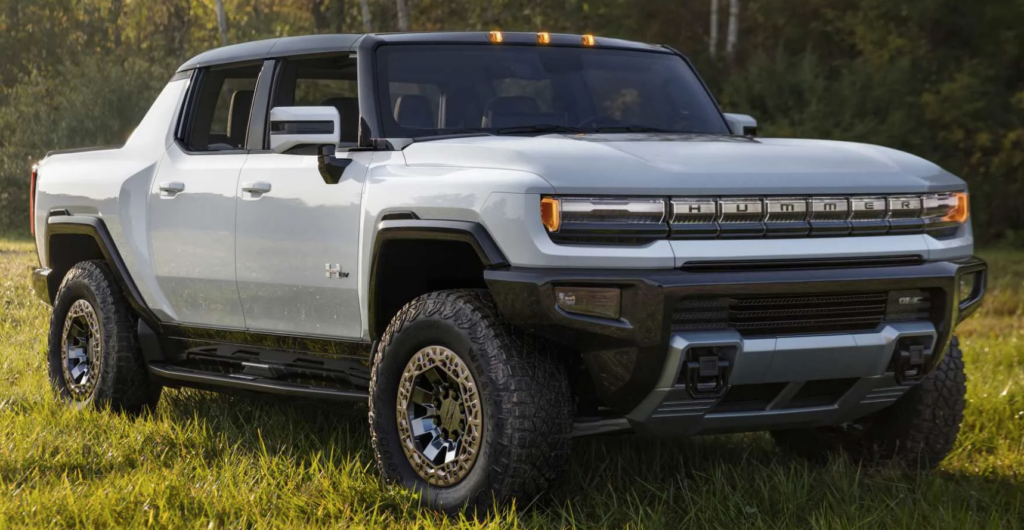
Price: $90,000-120,000 (before markups of up to $100,000)
Range: 329 miles
Why it’s horrible: Where do we start? The Hummer EV costs $100 to charge (because it has a MASSIVE 212 kilowatt-hour battery pack), weighs 9000 pounds (that’s 2x the weight of the typical F-150), and is horrible for the environment. If you’re looking to go green with your EV purchase, this isn’t it. It’s also very expensive, but that’s less surprising these days.
At auction, we’ve seen many Hummer EVs selling for over $200,000. No thanks.
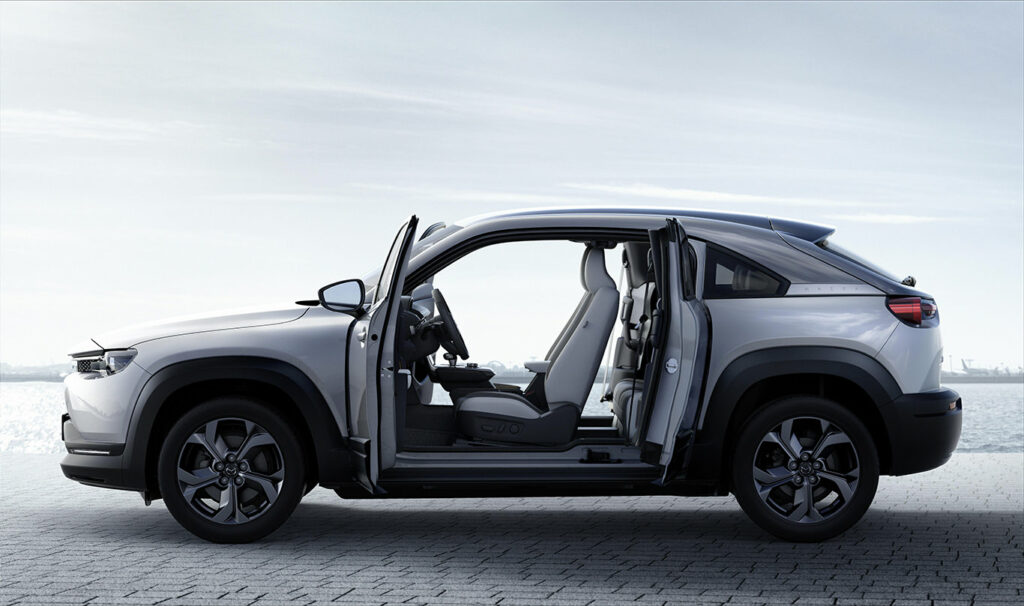
Price: $34,000
Range: 100 miles
Why it’s horrible: If you’re considering the Mazda MX-30, send me an email at [email protected]. I’d like to talk you out of it. I have nothing against Mazda as a brand (they make some awesome cars), but I am very against anyone buying an electric car with just 100 miles of range in 2022. Sure, maybe it’s just for around town. Have you thought about resale value? With barely 100 miles on a charge and slow charge times of around one hour, I’m afraid Mazda’s first EV won’t be worth its scrap metal value in a decade.
Other options to consider at this price point? The Nissan LEAF, base Volkswagen ID.4, Chevrolet Bolt, and soon-to-come Chevrolet Equinox EV are all far more capable for under $40,000.
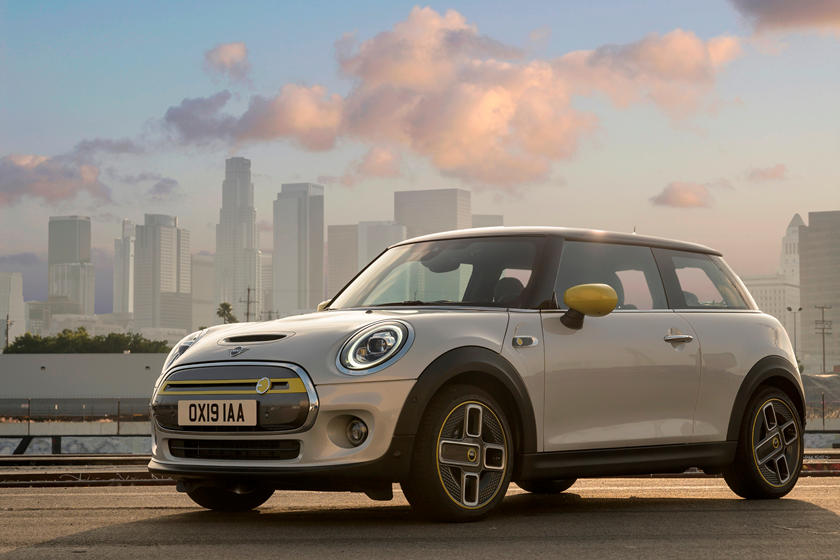
Price: $34,000
Range: 110 miles
Why it’s horrible: I sure hope CarEdge’s own Ray Shefska forgives me for bashing the electric MINI, but with 110 miles of range and slow charging, I don’t see a single reason why anyone should consider this EV. It’s one of the last ‘compliance cars’ in the EV market.
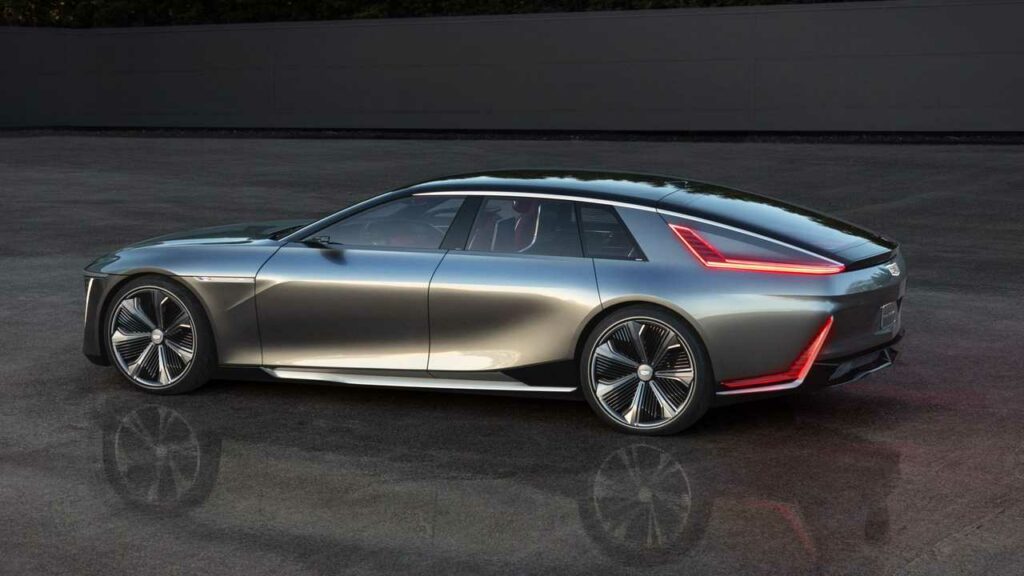
Price: $300,000+ (yes, count those zeroes)
Range: 300+ miles
Why it’s horrible: Would you pay Rolls Royce money for a Cadillacl? GM seems to think you would. I’m all for going all-out on EV design and innovation, but when Cadillacs cost more than houses, I can’t help but shutter. But hey, it will be hand-built.

New car inventory is rising, and that motivates automakers to offer better incentives. Cyber Monday 2023 will be a great time to buy if you’re in the market for a new car. Before you run out to buy a car on Cyber Monday (November 27), here’s what you need to know:
Cyber Monday car sales are out now. See the best deals posted below.

#1 Jeep – No payments for 90 days, and 10-15% off MSRP
2023 Grand Cherokee L Laredo 4×4: 10% off of MSRP advertised
2023 Renegade Latitude 4×4: 15% off of MSRP advertised
2023 Compass Latitude Lux 4×4: 15% off of MSRP advertised
Learn more about these offers at Jeep.com
#2 Nissan – 0% APR offers for popular models
Learn more about these offers at NissanUSA.com
#3 Mazda – 0.9% APR for select 2023 models
Learn more about these offers at MazdaUSA.com
#4 Chevrolet – Low APRs and cash offers
2024 Equinox: 1.9% APR for 36 months + $1,000 bonus cash, or 2.1% APR and $1,250 for the 2023 Equinox
2023 Silverado 1500 Crew Cab RST: 1.9% APR for 36 months + $2,000 cash allowance
Learn more about these offers at Chevrolet.com
#5 Ram – Low APRs, and big cash offers
2023 Ram 1500: 3.9% APR for 72 months, and between $4,000-$5,200 bonus cash
Learn more about these offers at Ramtrucks.com
#6 GMC – Low APR offers for trucks and SUVs
2023 GMC Sierra: 0.9% APR
2023 GMC Terrain, Acadia: 1.9% APR
Learn more about these offers at GMC.com
#7 Kia – Cyber Monday Sales
2023 Kia EV6: 0.9% APR for 48 months, and $5,000 bonus cash. The 2024 Kia EV6 offer is for 1.9% APR for 48 months, and $3,750 bonus cash.
2023, 2024 Niro EV: 0.9-1.9% APR for 48 months and up to $3,750 cash offer.
2023 Sorento: 1.9% APR
Learn more about Kia offers at Kia.com
#8 Hyundai – Low APR Financing Deals
2024 Tucson: 0% APR for 60 months, no payments for 90 days, up to $2,500 off MSRP
2023 Santa Fe: 0% APR for 60 months, no payments for 90 days, up to $3,500 off MSRP
2024 IONIQ 5 and IONIQ 6: 0.9% APR financing offer
Learn more about Hyundai Cyber Monday sales at HyundaiUSA.com
#9 Cadillac – The Best Luxury Car Sales
2023 Cadillac XT4: 2.9% APR for 36 months, plus $1,000 cash allowance
2023 Cadillac XT5: 2.9% APR for 36 months, plus $2,000 cash allowance
Learn more at Cadillac.com
#10 Lease deals are GREAT this month

Auto loan rates now average north of 7% for new cars, and 14% for used cars. Leasing is one way to avoid paying interest, especially for well-qualified buyers (those with decent credit scores). Here are some of the best value lease deals in November:
2024 Kia Seltos: $269/month for 36 months with $2,999 due
2024 Buick Envista: $179/month for 24 months with $3,819 due
2023 Chevrolet Equinox: $269 per month for 24 months with $1,849 due
2023 Mazda CX-30: $279 per month for 36 months with $2,999 due
2024 Kia Carnival: $409/month for 36 months with $3,499 due
See all of this month’s best lease offers here.
Whether you’re in the market for a new or used car, a lot can change in the span of a month. Cyber Monday car deals are just the tip of the iceberg. In 2023, new car inventory is much higher than in recent years. There are A LOT of 2023 models still needing to be sold, especially when it comes to General Motors, Ford, Jeep and Ram.
So, what’s the difference between taking advantage of Cyber Monday car deals and waiting a bit longer? Those with patience are likely to be rewarded with the best deals yet in 2023: year-end car sales. Let’s take a look at why this is so…
In summary, there will be better new and used car deals in December. We’ll have the best year-end car deals posted here.
We’ve sorted through ALL of the ads to find you the biggest and best Cyber Monday car deals in 2023.

Interest rates average north of 7% for new cars, so it’s a big deal when zero percent interest offers return. The following models are all advertised for 0% APR in November:

Get your hands on these models with 0.9% APR for qualified buyers. Most low APR offers are for remaining 2023 model year inventory. It’s great to see some excellent Mazda deals this month. Mazda has been rising in popularity in recent years, with good reason.
The GMC Sierra at 0.9% APR is hard to beat. Hyundai’s electric vehicles are the fastest-charging EVs for under $50,000. Since they lost the federal tax credit, they’ve been slow sellers.
These are the models advertised with 0.9% APR in November:
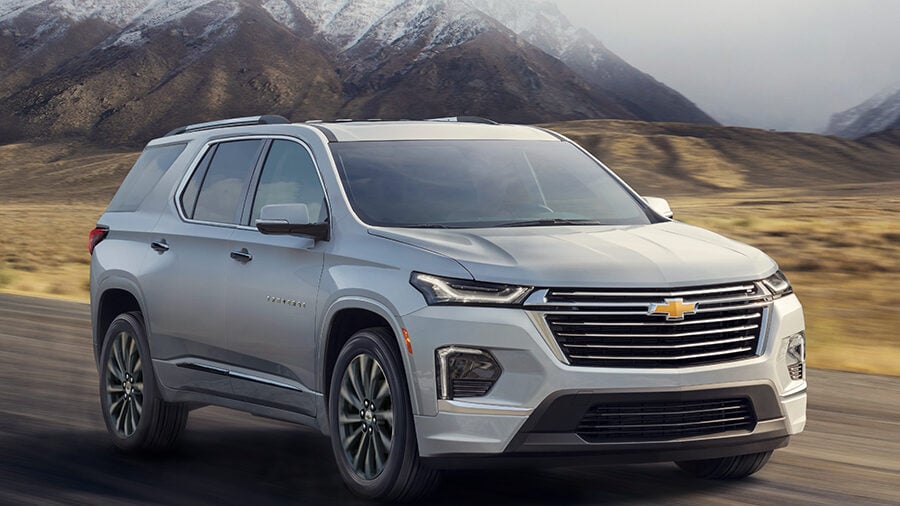
General Motors has plenty of inventory today, and is bringing low APR offers to attract buyers. These are the models with 1.9% to 2.1% APR offers in November.
2023 Chevrolet Equinox, Trailblazer, Blazer, and Traverse
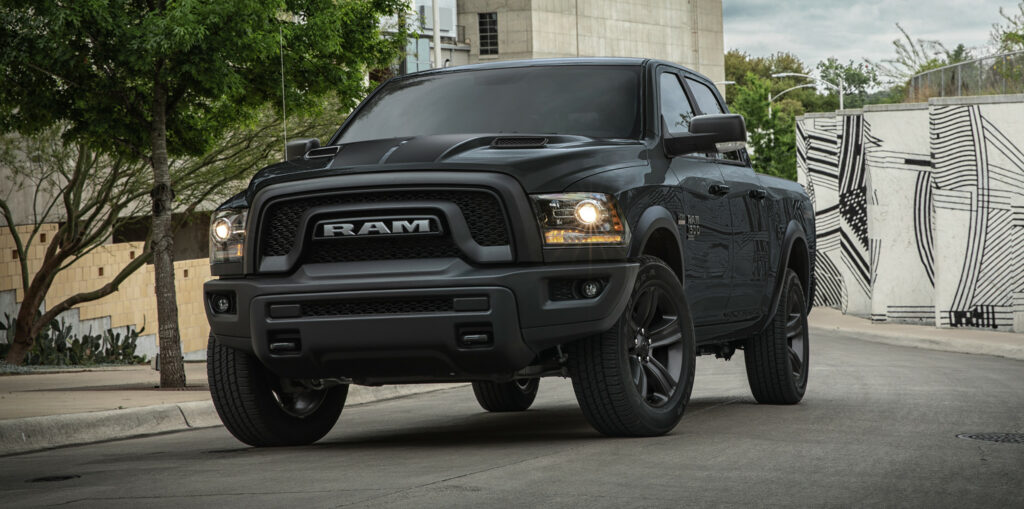
Some manufacturer incentives include a hefty amount of cash bonus for your deal. We’ve picked through all of the sales to find you the best cash incentives this month:
Jeep has massive cash discounts right now, plus no payments for 90 days. Here are the best Jeep offers in November:
2023 Grand Cherokee L Laredo 4×4: 10% off of MSRP
2023 Renegade Latitude 4×4: 15% off of MSRP
2023 Compass Latitude Lux 4×4: 15% off of MSRP
2023 Gladiator Sport 4×4: 10% off of MSRP
Stellantis has sky-high inventory right now, and dominates the rest of the best cash offers:
2023 Ram 1500: 3.9% APR for 72 months, and between $4,000-$5,200 bonus cash
2023 Kia EV6: 0.9% APR for 48 months, and $5,000 bonus cash
2024 Kia EV6: 1.9% APR for 48 months, and $3,750 bonus cash
2024 Hyundai Tucson: 0% APR, $2,500 cash discount
2023 Hyundai Santa Fe: 0% APR, $3,500 cash discount
2023 Dodge Challenger and Charger: $2,000 cash offer, 6.9% APR
2023 Dodge Durango: $5,500 cash allowance, 6.9% APR
2023
2023 Ford F-150: up to $2,500 in cash bonus
2023 Chevrolet Silverado 1500 Crew Cab RST: 1.9% APR for 36 months + $2,000 cash allowance

Ready to outsmart the dealerships? Download your 100% free car buying cheat sheets today. From negotiating a deal to leasing a car the smart way, it’s all available for instant download. Get your cheat sheets today!

Did you know that new car incentives are 40% higher during one particular time of the year? It’s amazing how much money you can save with a bit of knowledge that car dealers don’t want to share. At CarEdge, we strive to make car buying and ownership easier, less expensive, and simply a better experience. In this guide, we’ll go over the best time of the year for buying a car. If you’re determined to spend less on your car, we think you’ll find this information valuable.
As manufacturer incentives plummet, car buyers are looking for other ways to save.
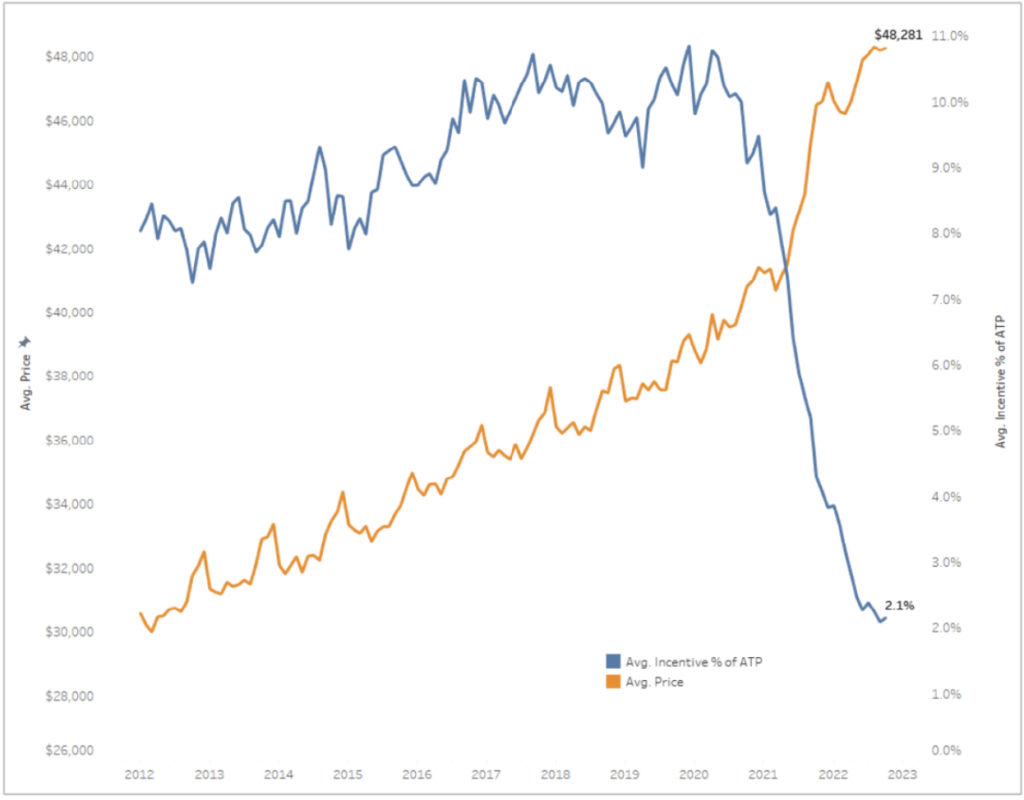
The demand for new and used cars continues to outpace supply as automakers have a really hard time increasing production. Global supply shortages have affected car makers on every continent. However, the situation for car buyers is improving in late 2022. After almost two years of ridiculous prices, deals can finally be negotiated.
The best time of the year to buy a car has changed. Pre-pandemic monthly trends may return someday (if automakers ever get back to normal inventory levels), but let’s talk about where things stand in 2022 and early 2023.
In late 2022 and early 2023, new and used car prices are dropping. This is not a normal time for car price trends. Price declines are more pronounced in the used car market, but select new models are negotiable too.
Let’s cut to the chase:
The best time to buy a car lies in the months ahead. Deals can be negotiated today, but your leverage for lower prices will increase in December and in early 2023.
The last week of the year is usually the best time to buy a car. Incentives and negotiation leverage improve as dealers hurry to move the last of the previous model year off of their lots.
Let’s talk about the used car market. Wholesale price declines are finally translating to lower used car prices (more on that here). This was confirmed by the November Consumer Price Index (CPI) report that showed used car prices were down -2.4% month-to-month when seasonally adjusted. New car prices remained nearly flat at +0.4%, the smallest new car price increase in 2022.
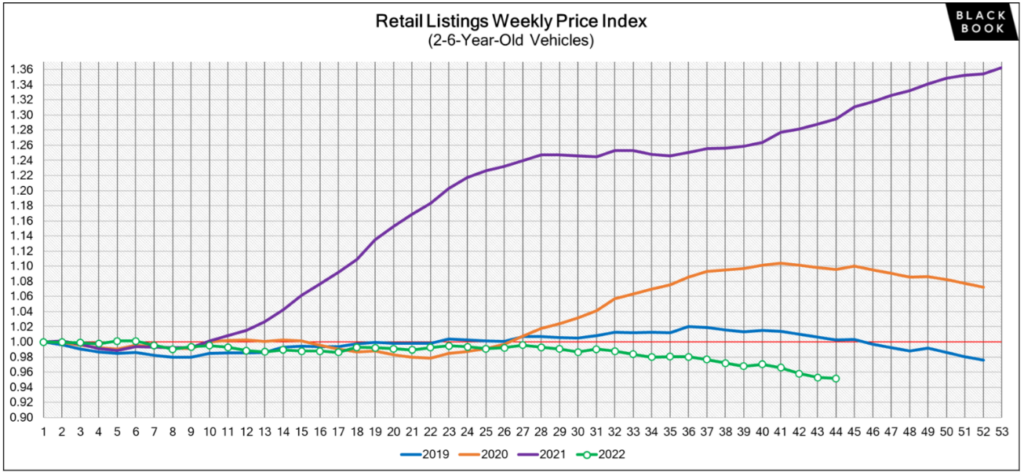
We track used car prices weekly. See this week’s used car price update.
New car prices are softening, despite automakers steadily raising MSRPs. Don’t expect widespread MSRP drops anytime soon. However, there lies hope in the slow return of manufacturer incentives and the demise of additional dealer markups.
Our CarEdge Auto Experts have noted that domestic brands like GM, Ford, Chrysler most often present the best opportunity to get a deal under MSRP.
In other words, your chances of buying a new car at or below MSRP are better now than at any time in the past 18 months.
The longer you wait (into 2023), the more negotiation power you’ll have as the overall new car market softens.
However, when it comes to total cost, it’s not that simple. Interest rates are rising to the highest levels in over a decade. If you wait longer to buy, there’s a real chance that the cost of financing may rise to the point where your monthly payments end up higher due to interest. Here’s the latest on car loan interest rates.
Wouldn’t it be nice to finance your car with someone you trust? Finance with CarEdge! We work with trusted credit unions offering low rates and great customer service. Learn more and get pre-approved in minutes!
The average transaction price (ATP) of new cars has hovered around $48,000 for months. The latest data shows it continues to remain at that level. How could we possibly advocate for negotiating lower prices? The data shows that luxury car shoppers continue to buy, and that has been driving up the overall market average. Deals are out there, if you know where to look.
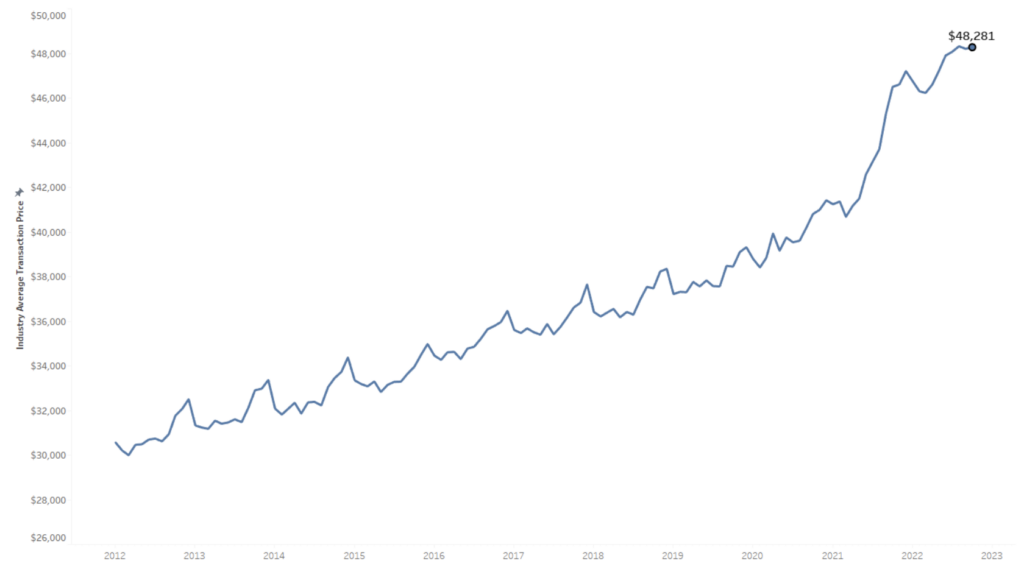
With market conditions always changing, we believe that knowledge is power. CarEdge’s Auto Experts are just one of the great benefits of CarEdge Membership. Learn more about our plans. How much money can you save? Read CarEdge member success stories!
Pre-pandemic data from Edmunds shows that the time around Labor Day is when most new car incentives begin, with discounts growing as the year comes to an end. Better deals continue on outgoing model years through fall and winter as new models compete with outgoing model years for space on dealer lots.
Many automakers roll out the new model year by September. If you’re okay with the outgoing model year, you have significantly more leverage to negotiate prices down. Don’t show up to the dealership expecting thousands of dollars off of the brand-new model year unless demand for new cars falls off a cliff (as it did in 2020).
Negotiate like a PRO with this free dealership cheat sheet. Don’t buy a car without it!
Year-end car deals most often arrive as manufacturer incentives (which we keep track of every month). New car incentives were at historic lows during the worst of the chip shortage, but they’re slowly coming back as recession fears hit demand.
Here’s how current model-year savings compare with new model-year cars. Remember, these were the historic norms, and the situation in 2022-2023 has changed dramatically.
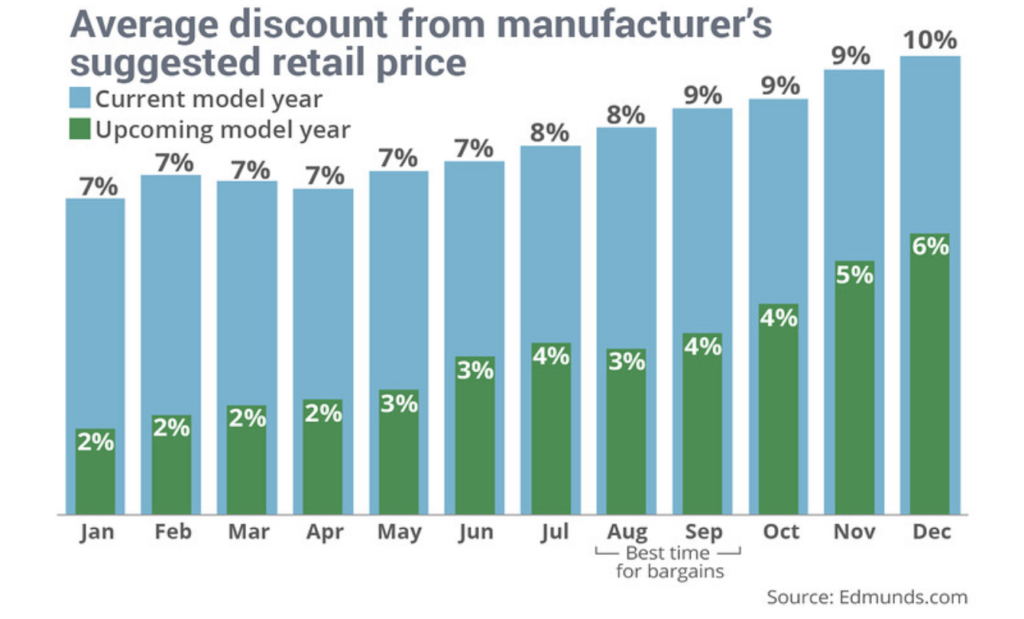
Would you have guessed that used car prices have fallen nearly 14% at wholesale markets since last summer? probably not, because it wasn’t until September that car prices dropped at the retail level. The car market is changing as automakers slowly come out of the semiconductor chip shortage, and consumers hold back on spending as recession fears circulate.
Here’s the bottom line: rapidly-changing car market conditions are likely to overshadow the seasonal trends that we’ve seen historically in pre-COVID times.
After 18 months of price increases, used car prices are dropping. Even if sticker prices are nearly the same, at CarEdge, we’ve had more members scoring deals under the advertised price. That’s why we think you should negotiate 5-10% off of a car purchase today.
On the new car front, negotiation leverage depends on three main factors: 1) vehicle supply, 2) local dealer inventory and 2) demand for the specific model and trim.
See the latest new car inventory numbers here.
For example, our CarEdge auto experts joke that everyone wants a Toyota RAV4 Prime right now. Demand is through the roof, Toyota is hardly producing any, and therefore prices for the RAV4 Prime remain insanely high.
On the other hand, some new car models have more inventory than at any time in the past year. New car inventory isn’t on par with pre-pandemic levels, but it’s an improvement. Pair that with reduced demand, and new cars are finally becoming more negotiable. Dealer markups do exist for popular models, but you CAN negotiate pricing on new cars again.